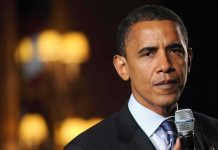
President Trump demands a two-percentage-point interest rate cut that could save America $600 billion annually, blasting Federal Reserve Chair Powell for economic “malpractice” while the Fed remains cautious about inflation risks from new tariffs.
Key Takeaways
- President Trump is escalating pressure on the Federal Reserve to cut interest rates by two percentage points, which he claims would save $600 billion annually.
- Vice President JD Vance has called the Fed’s refusal to cut rates “monetary malpractice” despite controlled inflation levels.
- The Federal Reserve is hesitant to lower rates due to concerns that Trump’s tariff policies could trigger renewed inflation.
- Trump has confirmed he won’t fire Powell but continues to publicly criticize his leadership at the central bank.
- Economists predict Trump’s tariffs could push inflation to 3.5%-4% by late 2025, complicating interest rate policy.
Trump Intensifies Push for Lower Interest Rates
President Donald Trump has significantly escalated his criticism of Federal Reserve Chair Jerome Powell during a June 12 White House event, demanding immediate action on interest rates. The President is advocating for a substantial two-percentage-point reduction in rates, asserting that such a move would result in approximately $600 billion in annual savings for the United States. This latest round of criticism represents a continuation of Trump’s longstanding dissatisfaction with the Fed’s monetary policy, which he believes is hampering economic growth during his administration.
While the President has been vocal about his displeasure with Powell, he clarified during the event that he does not intend to remove the Fed Chair from his position. Instead, Trump is focused on applying public pressure to influence a change in monetary policy direction. The administration’s position is that current inflation levels are sufficiently controlled to justify immediate rate cuts, which would stimulate economic growth and reduce the government’s interest payment burden on its substantial national debt.
President Trump lashed out at Federal Reserve Chair Jerome Powell, branding him a "numbskull" for not lowering interest rates. Trump argued that a 2-point rate cut would save the U.S. $600 billion annually, intensifying pressure on Powell amid debates about inflation and economic… pic.twitter.com/m44D5Y6KN7
— Money (@Money) June 13, 2025
The Administration’s Economic Strategy Faces Fed Resistance
Vice President JD Vance has joined the President in criticizing the Federal Reserve’s current stance, characterizing the central bank’s reluctance to cut rates as “monetary malpractice.” “The president has been saying this for a while, but it’s even more clear: The refusal by the Fed to cut rates is monetary malpractice,” said JD Vance, Vice President of the United States.
The administration’s economic strategy involves both implementing protective tariffs on imports and pushing for looser monetary policy. However, economic analysts point out a fundamental tension between these goals. Powell and the Federal Reserve have signaled that the tariffs themselves may prevent the interest rate cuts Trump desires. The central bank remains concerned that tariffs will increase consumer prices across various sectors, potentially reigniting inflation that has only recently shown signs of cooling.
The Inflation-Tariff Connection
The Federal Reserve’s hesitancy to cut rates stems from its institutional memory of being caught off guard by inflation surges in recent years. Powell has explicitly connected Trump’s tariff policies to potential economic risks, stating, “If the large increases in tariffs that have been announced are sustained, they are likely to generate a rise in inflation, a slowdown in economic growth, and an increase in unemployment,” said Jerome Powell, Federal Reserve Chair.
Economic forecasts suggest that Trump’s proposed tariffs could push inflation rates to between 3.5% and 4% by the end of 2025, well above the Fed’s 2% target. This creates a challenging environment for monetary policy decisions. Some analysts believe that without the looming tariff policies, the Federal Reserve might have already begun reducing interest rates. Instead, market predictions now suggest rate cuts may not materialize until later in the year, and their timing will be heavily influenced by how tariff policies affect inflation metrics.
Economic Implications for American Households
The ongoing tension between tariff policies and interest rates has significant implications for American households and businesses. Higher interest rates continue to affect everything from mortgage payments to business loans, while tariffs could simultaneously raise prices on imported goods. This combination presents a potential double burden on consumers already frustrated with the lingering effects of inflation from recent years. The administration’s position is that rate cuts would provide immediate relief to American families while tariffs protect American jobs and industries.
While some of Trump’s economic advisers likely understand the Federal Reserve’s cautious approach, the public criticism serves a strategic purpose. By positioning the Fed as an obstacle to economic prosperity, the administration creates a potential explanation should economic growth not meet expectations. However, many economists argue that removing or reducing proposed tariffs might actually benefit Americans more directly by keeping prices lower and giving the Federal Reserve the flexibility to implement the interest rate cuts the President desires.







